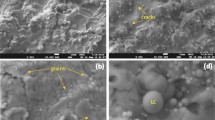Abstract
Ni–Al2O3 functionally graded materials (FGMs) have become important for high-temperature applications due to a continuous change in composition. However, the manufacturing of Ni–Al2O3 FGMs with conventional machining methods is a long and costly process because of the insulating ceramic composition. This paper presents a new method of machining Ni–Al2O3 FGMs by self-induced electrical discharge machining (EDM). Self-induced EDM uses the conductive compositions of Ni–Al2O3 FGMs to trigger the discharges in the insulating composition. Machining characteristics of a four-layered Ni–Al2O3 FGMs drilled by self-induced EDM have been investigated, which include the material removal mechanisms, discharge properties, surface characteristics, material removal rate, and electrode wear ratio. It has been found that graded layers, 70 % Ni-graded layer and 30 % Ni-graded layer, are removed by dislodgement of Al2O3 particles, in addition to conventional melting and evaporation. Pure Al2O3 layer is melted and evaporated by utilizing conductive layer-induced discharges. The discharge properties, surface characteristics, material removal rate, and electrode wear ratio are significantly influenced by the material removal mechanisms of graded compositions. These findings demonstrate that self-induced EDM is able to effectively machine Ni–Al2O3 FGMs.
Similar content being viewed by others
References
Garcia J, Pitonak R (2013) The role of cemented carbide functionally graded outer-layers on the wear performance of coated cutting tools. Int J Refract Met Hard Mater 36:52–59
Yadroitsev I, Bertrand P, Laget B, Smurov I (2007) Application of laser assisted technologies for fabrication of functionally graded coatings and objects for the international thermonuclear experimental reactor components. J Nucl Mater 362:189–196
Hedia HS (2005) Design of functionally graded dental implant in the presence of cancellous bone. J Biomed Mater Res B 75:74–80
Chen JY, Huang H, Xu XP (2009) An experimental study on the grinding of alumina with a monolayer brazed diamond wheel. Int J Adv Manuf Technol 41(1–2):16–23
Agarwal S, Rao PV (2008) Experimental investigation of surface/subsurface damage formation and material removal mechanisms in SiC grinding. Int J Mach Tools Manuf 48:698–710
Muller F, Monaghan J (2000) Non-conventional machining of particle reinforced metal matrix composite. Int J Mach Tools Manuf 40:1351–1366
Yue TM, Lau WS (1996) Pulsed Nd:YAG laser cutting of Al–Li/SiC metal matrix composites. Mater Manuf Process 11:17–29
Rozenek M, Kozak J, Da Ibrowski L, Eubkowski K (2001) Electrical discharge machining characteristics of metal matrix composites. J Mater Process Technol 109:367–370
Garg RK, Singh KK, Sachdeva A, Sharma VS, Ojha K, Singh S (2010) Review of research work in sinking EDM and WEDM on metal matrix composite materials. Int Adv Manuf Technol 50:611–624
Puertas I, Luis CJ (2012) Optimization of EDM conditions in the manufacturing process of B4C and WC-Co conductive ceramics. Int J Adv Manuf Technol 59(5–8):575–582
Clijsters S, Liu K, Reynaerts D, Lauwers B (2010) EDM technology and strategy development for the manufacturing of complex parts in SiSiC. J Mater Process Tech 210:631–641
Yan BH, Tsai HC, Yuan Huang F, Chorng Lee L (2005) Examination of wire electrical discharge machining of Al2O3p/6061Al composites. Int J Mach Tool Manuf 45:251–259
Patil NG, Brahmankar PK (2010) Some studies into wire electro-discharge machining of alumina particulate-reinforced aluminum matrix composites. Int J Adv Manuf Technol 48(5–8):537–555
Satishkumar D, KanthababuM VV, Anburaj R, Sundarrajan NT, Arul H (2011) Investigation of wire electrical discharge machining characteristics of Al6063/SiCp composites. Int J Adv Manuf Technol 56(9–12):975–986
Seo Y, Kim D, Ramulu M (2006) Electrical discharge machining of functionally graded 15–35 Vol % SiCp/Al composites. Mater Manuf Process 21:479–487
Mohri N, Fukuzawa Y, Tani T (1996) Assisting electrode method for machining insulating ceramics. CIRP Ann-Manuf Technol 45(1):201–204
Liu YH, Ji RJ, Li XP, Yu LL, Zhang HF, Li QY (2008) Effect of machining fluid on the process performance of electric discharge milling of insulating Al2O3 ceramic. Int J Mach Tools Manuf 48:1030–1035
Schubert A, Zeidler H, Hahna M, Hackert-Oschätzchena M, Schneider J (2013) Micro-EDM milling of electrically nonconducting zirconia ceramics. Procedia CIRP 6:298–303
Yang SK, Kim HS, Lee CS (2013) Investigation of shrinkage control in Ni–Al2O3 (metal–ceramic) functionally graded materials. Ceram Int 39:93–99
Zhang Z, Peng H, Yan J (2013) Micro-cutting characteristics of EDM fabricated high-precision polycrystalline diamond tools. Int J Mach Tools Manuf 65:99–106
Konig W, Dauw D, Levy G, Panten U (1998) EDM-future steps towards the machining of ceramics. CIRP Annals 37:623–631
Muttamaraa A, Fukuzawab Y, Mohri N, Tani T (2009) Effect of electrode material on electrical discharge machining of alumina. J Mater Process Tech 209:2545–2552
Author information
Authors and Affiliations
Corresponding author
Rights and permissions
About this article
Cite this article
Liu, H., Wang, Z., Wang, Y. et al. Self-induced electrical discharge machining of Ni–Al2O3 functionally graded materials. Int J Adv Manuf Technol 83, 587–594 (2016). https://doi.org/10.1007/s00170-015-7568-2
Received:
Accepted:
Published:
Issue Date:
DOI: https://doi.org/10.1007/s00170-015-7568-2




